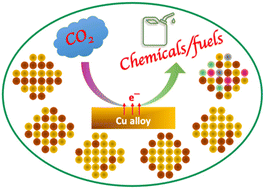Alloying strategies for tuning product selectivity during electrochemical CO2 reduction over Cu
Abstract
Excessive reliance on fossil fuels has led to the release and accumulation of large quantities of CO2 into the atmosphere which has raised serious concerns related to environmental pollution and global warming. One way to mitigate this problem is to electrochemically recycle CO2 to value-added chemicals or fuels using electricity from renewable energy sources. Cu is the only metallic electrocatalyst that has been shown to produce a wide range of industrially important chemicals at appreciable rates. However, low product selectivity is a fundamental issue limiting commercial applications of electrochemical CO2 reduction over Cu catalysts. Combining copper with other metals that actively contribute to the electrochemical CO2 reduction reaction process can selectively facilitate generation of desirable products. Alloying Cu can alter surface binding strength through electronic and geometric effects, enhancing the availability of surface confined carbon species, and stabilising key reduction intermediates. As a result, significant research has been undertaken to design and fabricate copper-based alloy catalysts with structures that can enhance the selectivity of targeted products. In this article, progress with use of alloying strategies for development of Cu-alloy catalysts are reviewed. Challenges in achieving high selectivity and possible future directions for development of new copper-based alloy catalysts are considered.

- This article is part of the themed collections: CO2 capture and conversion and Recent Review Articles


 Please wait while we load your content...
Please wait while we load your content...